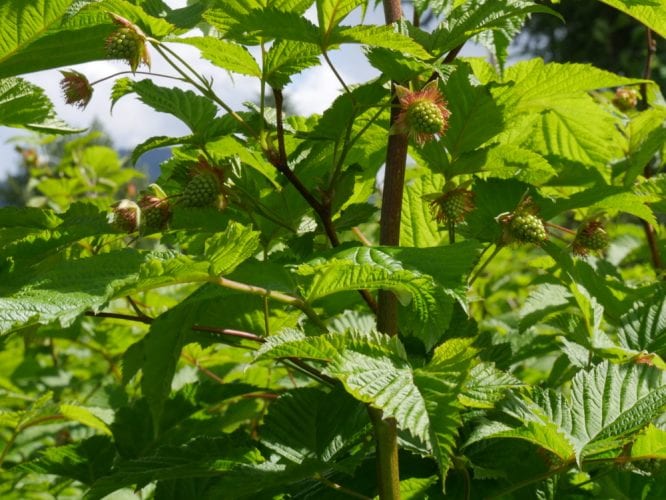
Salmon berries are a little late to ripen this year with cool temperatures and rainy weather likely to continue into July.
The rainy, cool weather in Southeast Alaska this month is likely to continue in the near future, despite a short break in the showers expected this week. That might mean a little later and less sweet year for wild berries.
Audio PlayerWhile it’s probably not setting records, Petersburg is experiencing a wetter and cooler month than usual. The normal monthly rainfall total for June is just under five inches. The town has already surpassed that with over a week left in the month.
National Weather Service forecaster Rick Fritsch specializes in the climate of Southeast Alaska and doesn’t see big changes on the horizon. “The current pattern that we’re in and have been in for all of June so far, I cannot see that it’s gonna change anytime soon,” Fritsch said. “And so I would say there is a fairly good chance that we are gonna see above normal precipitation going into July. Climatologically this is supposed to be the driest part of the year.”
Instead, the region is seeing higher than normal rainfall because of repeated storms blowing through. Fritsch said it’s different than the weather phenomenon called an atmospheric river that brings a steady stream of moisture to the region. “It’s not so much of an atmospheric river, but rather luck of the draw and just bad timing with a lot of lows showing up in the Gulf of Alaska courtesy of the location of the jet stream.”
Along with the extra precipitation, Petersburg is seeing cooler than normal daytime high temperatures. The June average maximum temperature is just under 62 degrees. So far this month, the average maximum temperature in Petersburg is only 56.4 degrees. Fritsch calls that a big difference in temperatures. “Some folks would say well you know four degrees that’s not that big of a deal,” he said. “Day to day variability, absolutely, four degrees, not big deal but when you start looking at a month’s worth of temperatures, certainly three months of temperatures, and you talk in terms of more than one or two degrees Fahrenheit that is a big deal. So this is very anomalously cold month for Petersburg in terms of the daytime maximum temperature.”
Fritsch said lower level cool air is being drawn into the region from Interior Alaska by the repeated low-pressure systems coming through the panhandle. While daytime highs have been chilly, overnight low temperatures have been pretty close to average.
With sunlight a little scarce this year some wild plants might be a little late in blooming and producing berries this year. Some have been wondering when popular wild foods like salmon berries and blue berries will be ripening.
“We’ve been seeing berries developing here in the Juneau area,” said Darren Snyder a cooperative extension agent with the University of Alaska Fairbanks’s cooperative extension service’s Juneau office. “They may be a little bit later than in previous years but we do see them developing on the bushes. And there are quite a few things that will play into when they ripen, when they are ready for harvest.”
Some of the factors for berry development are daylight, temperature and sunshine, or lack of it. Snyder and others say the late berry development is nothing out of the ordinary and berry ripening can vary widely depending on yearly weather variations. Snyder explained a little bit of sunshine will help with sweeter berries.
“The plants here in Southeast Alaska are used to having a good amount of cloud cover,” he said. “They’ve all adapted to that but the more sun, the quicker they’ll ripen and also the more sweet they’ll be. They can even ripen and look really nice and lovely and bright but just not be quite as sweet because there hasn’t been as much photosynthesis going on. And that’s a function of the light but also the temperature and how much actual sugar production is going on in the plant.”
Snyder said the wild berries in his backyard are nowhere near ripe yet. But for people growing crops he encourages taking steps to increase temperature and keep rain off by growing in a greenhouse to help plants develop more quickly this cool rainy summer.










